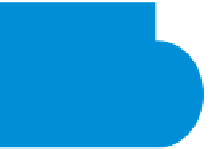Graphics Programs Reference
In-Depth Information
page header takes up the top third of the page, leaving the bottom two-thirds of the page
for content.
Rhythm and Unity
Rhythm is achieved in a page by repetition or alternation of objects or elements in the
page. For example, a color that is repeated in different places in the page helps cre-
ate a sense of rhythm or fl ow to the page. Unity speaks to the relationship of the indi-
vidual objects in the page as they relate to the composition of the whole page. Using
one graphic style throughout the site, repeating colors throughout the site, and creat-
ing balance and symmetry between the objects in the pages all help to create unity in
the design.
Often, two, or three effective layouts are possible. Initially, designers create rough
sketches of possible layout designs. Sometimes designers create wireframes of the site
layout.
Wireframes
are barebones page mockups that are created in a graphics program
instead of being drawn by hand. Wireframes include only rough placeholder images
such as boxes with text to indicate where a button will be placed. The purpose of creat-
ing wireframes is to show placement of navigation, logo, and other layout elements to
the client before creating the actual artwork. Because many clients are visual and need
to see some basic artwork to grasp the site's aesthetic design, often the client and design
team forgo wireframes and instead choose the sketch that they like best. Then, they cre-
ate
comps
(comprehensive drawings) or
storyboards
, from the sketch. The comps or sto-
ryboards are fully developed, detailed drawings that provide a complete preview of what
the fi nal design will look like. Think of them as a pictorial overview that communicates
the story of the Web site. They often include elements such as fi lenames, page titles,
page headings, a navigation system, images, text, and link information. As you build the
Web site, be sure to compare the sites to the storyboard to be sure the intended design is
being implemented.
Gage developed rough sketches of two possible layouts for the new NextBest Fest site,
as shown in Figure 2-13. The fi rst sketch places the site navigation system at the top of
the page, and the second sketch places the site navigation system along the left side of
the page. Although both layouts are effective, Gage decided to go with Layout 1. The top
navigation system makes better use of the available space and appears to fl ow better with
the selected graphic style.

Search WWH ::

Custom Search